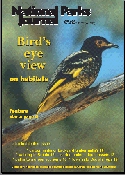
Back to Contents
|
 Editor : Rosemary Pryor |
 Back to Contents |
|
|
Readers
are welcome to respond by letter or e-mail (editor@npansw.org.au)
to other letters or articles in the
National Parks Journal, or to write in about whatever you like. Preference
will be given to short, concise letters. Other letters may be edited or not included,
depending on space limits. |
Ad Complaints 'off-the air'
It was interesting to read David Bennetts's letter about the Pajero advertisement (Journal, Feb.02). I was so incensed when the ad first appeared on television, I tried to complain to an advertising complaints board, only to find there is no such thing.
However, via the
National Womens Media Centre, (http://www.nwmc.org.au/action/Complaints/advertisingcomplaints.htm)
I sent a complaint to the advertising industry’s self-regulatory group, and
eventually received a reply that they saw no problem with the advertisement.
It seems to me that two things are needed. An independent advertising complaints board, and the banning of Off Road Vehicle (ORV) advertising.
I have yet to see an ORV ad that does not have some sort of footage of inappropriate, environmentally damaging driving. There are so many environmental problems with ORVs, maybe they should be banned unless absolutely necessary for work or property access!
Karen Joynes
Wooloweyah
13 February 2002
|
Marine
Park Acid Test? Recent argument opposing the Jervis Bay Marine Park (JBMP) serves to highlight the complexity of environmental issues. One worthwhile suggestion made by the opposition was to take action to reduce or prevent acid soil runoff, to help preserve fish stocks instead of declaring ‘no-catch’ zones. Acid soil runoff is caused by land clearing and land disturbance in inappropriate sites and also by the draining and filling of wetlands. Following the recent fires, there have been calls for 150-metre wide buffers in National Parks, and it is quite clear that a lot of illegal or unapproved tree removal has been taking place already around Jervis Bay. As well, on quite a few development sites, vegetation has been bulldozed and ground ripped without the required environmental assessment. All of this is occurring against a continuing background of ‘stealth’ landfilling and drainage of wetlands and low-lying lands. Without environmental assessment and controls on land clearing, we are in no position to know how much additional acid soil runoff is being caused by these unassessed activities. Fines for protesting have been increased from $50 misdemeanours, to criminal offences carrying multi-thousand dollar fines, seizure of assets and possible long terms of imprisonment. No one could expect anyone opposed to the JBMP to climb trees or chain themselves to the bulldozers of the illegal land clearers in efforts to prevent more acid soil runoff. Unfortunately, once the land has been cleared, there is little that can be done to restore it and prevent the acid soil runoff. Given that we cannot stop illegal or poorly assessed land clearing, the only sensible proposal to conserve fish is to declare the JBMP with extensive ‘no-catch’ zones. Peter Woof |
No Tunnel Vision
I believe Paul McCann (Letter, NPJ,Dec.2001) has misunderstood Norman Rich’s letter (NPJ, Oct. 2001) Mr Rich’s complaints are that the October Journal included an insert produced by Kuring-gai Council that NPA considers that Lane Cove NP is worthy of protection against inappropriate development.
I don’t know that any member of NPA's State Executive or of the Sydney Branch Committee has ever expressed opinions similar to those of Mr Rich. However, I believe that the Branch Committee would be enhanced if NPA members like Mr Rich and Mr McCann could find time to be corresponding members involved in the drafting of responses to EIS such as that for the Parramatta Rail Link (PRL) and the Lane Cove Tunnel.
I was involved in the Branch’s submission to the PRL EIS . However, this letter is a personal reaction to both the above letters. The Branch objected to either a bridge or a tunnel at the Fullers Bridge location, and proposed a rail bridge alongside the Epping Road bridge.(This would still impact on Lane Cove NP but in an area of bushland already degraded by road works and visited, in passing, only by walkers on the Great North Walk, of which I am one.)
After crossing the river, trains would enter one level of a dual purpose tunnel running under Mowbray Road and join the North Shore Line between Artarmon and St Leonards Stations. As Kuring- gai Council belatedly asked :"Y not a Y Link? " It also happens to be a more direct route from the Delhi Road station to the existing railway. This combined tunnel was
a non- preferred option in the Overview Report for the Lane Cove Tunnel but has disappeared without trace from the current EIS.
Minister Scully has shown that he is prepared to act on public submissions. Will Norman Rich, Paul McCann, and the residents of Roseville now concerned about the impacts of the PRL tunnel on their properties join me in writing to the Minister? We should again stress the lower construction and operating costs and the reduced environmental impacts of really integrated transport.
Implicit in the above is the rejection of the need for a station at the UTS Kuring- gai campus (which I believe is based on flawed statistical projections of patronage ). and of the need for further construction in an already overdeveloped Chatswood .
Reverting to Mr McCann’s final paragraphs I would expect that NPA would support a Blue Mountains rail tunnel over either a surface road or a road tunnel. However, the letter from State Treasurer Egan in the SMH of December 5 and the news of the cancellation or deferral of busways in the same issue suggests that a Blue Mountains tunnel is a much larger Pie in the Sky than a railway to Bondi Beach.
Alex Tucker, MIEAust
Frenchs Forest
13 January 2002
|
Sustainable
Transport still urgently needed
Firstly thank you to Alex Tucker for sending me a copy of his response to both my letter and Norman Rich's letter. I disagree with Alex on a number of matters. I did not misunderstand Norman Rich in his letter (NPJ, October). Norman's main concern is the quality of Sydney's air, caused mostly from excessive use of motor vehicles. He believes and I support his view that a railway crossing of the Lane Cove River will have considerably less impact on the local environment than a six- lane road. Unfortunately, air pollution does not stay in one place. The route of the proposed Parramatta to Chatswood Railway must join the existing North Shore Railway north of Chatswood if it is to achieve its major objectives. A 'Y' link as proposed by some would not allow trains to proceed directly from Parramatta to the city via Chatswood. The reasons for the rejection of the Y link are spelt out in the document Parramatta Rail Link – a summary of the Final Proposal. If the railway is to compete with the private car and thus reduce air pollution it must be attractive to the majority of commuters. Ideally the Parramatta to Chatswood railway should join up with the airport line allowing a direct service from the lower Blue Mountains and Central Coast via the North Shore to city and airport. A station at the UTS Kuringai campus will enable visitors to Lane Cove National Park to arrive by train instead of car. Car parks could be revegetated or turned into additional picnic areas. One may ask what transport policy has to do with national park management. The most compelling reason is to reduce air pollution and its long-term effects on our environment. In the US, park managers are adopting policies that keep cars out of parks and use public transport to move park visitors around the parks. NPA leaders could help [implement a sustainable transport policy here] by planning walks which use public transport or a hire bus! Paul McCann |
Alice in Natureland
I have only had the chance to dip into the book Ecological Pioneers: A Social History of Australian Ecological Thought and Action (special review, NP Journal February 2002) in a cursory fashion, but it leaves me rather perplexed. It deals with many important ‘Environmental Activists’ and a few ‘Ecologists’. It is an excellent source book on this account.
It does not, however, make mention, in the index at least, of our most important ecologists — Alex Costin, Len Webb, Harry Recher, Harry Frith to name but a few — many world-class and ‘activists’ in their own right. The environmental activists often drew heavily on the work and thought of the latter group but few would claim for themselves the title of ecologist and to have conferred this title is somewhat puzzling.
To have ignored the professional ecologists in a book bearing this title presents a very skewed picture indeed.
The authors are Social Ecologists. The Macquarie Dictionary gives an alternative definition to the familiar one for ecology as the "branch of sociology concerned with the spacing of people and of institutions and their resulting interdependence". Perhaps it is this which colours their thinking.
It seems to me that the semantics have led to the confusion. I am reminded of Alice in Wonderland, Ch VII "...you should say what you mean," the March Hare went on.
"I do," Alice hastily replied "at least — at least I mean what I say— that’s the same thing, you know."
"Not the same thing a bit!" said the Hatter. "You might just as well say that ‘I see what I eat’, is the same thing as ‘I eat what I see’!"
It is a shame that the title of the book is so misleading.
John (HC) Dorman
Bundanoon
17 February 2002
|
|
National
Parks Association - Home Page |
|